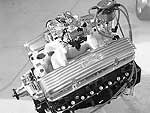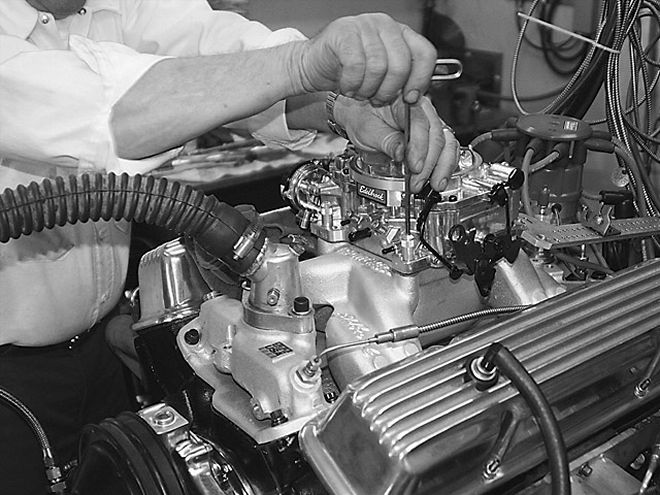
Heavy hitters for heavy rides. That's what we need. Few customs are lightweights, a fact that challenges their power to "get up and go." What we need is torque--lots of torque--because that's what makes the car go. Horsepower is cool for racing, but our rides need torque. Luckily for us, the folks at GM Performance Parts (GMPP) have already worked out a plan to build lots of torque into a package that's affordable and easy to get. We're talking about GMPP's HT 383 small-block crate engine. Designed and built to produce torque in the low-rpm range that rods and trucks see, the HT 383 is a fine choice for our heavy rides. Plus, it's easy to install; just about everyone has, or can make, headers for it, and hooking up transmissions is a piece of cake. All these benefits make the HT 383 even more desirable. So if you're looking to transplant some new muscle into your old rod, this is something you should check out.
LOW-END GRUNT
Too often, horsepower is the concern of an engine builder and the topic of much discussion on Saturday nights. Torque gets left out of the picture. But our heavy rods need torque even more than ordinary cars do so we have to be concerned with it. Otherwise, we'll be left in the dust by some stinkin' little import! With its advertised 435 lb-ft peak torque rating, and an observed 429 lb-ft in our dyno test, this little brute can take on any comer. Plus, with over 407 lb-ft of average torque all the way from 2,500 to its 5,000 rpm redline, this little puppy will plant you back in the seat and never let you out until your foot gets off the gas! And, with the skyrocketing prices of gasoline today, it's also nice to know that this motor was engineered to run on cheap 87-octane so you won't go broke feeding it every week.
OUR TEST MULE
For our test we wanted to build something a little retro, yet something a little extreme. GMPP usually offers its HT 383 as a complete long-block assembly including late-model Vortec iron heads, or even the hot, Fast-Burn aluminum heads, and a complete top end package. But we didn't want the look of newer heads under our hood, so we went with GMPP's new "492" reproduction heads. These heads feature all the performance of the rare classics, but also include some accessory boltholes on the ends to hang stuff like alternators and A/C, and to fool the cruise night gawkers, too. We also wanted to upgrade the unseen internals of this engine a bit as well. After all, we may be building a retro powerplant, but that doesn't mean we can't take advantage of some trick power parts. So we installed GMPP's recommended hydraulic roller camshaft and all its related parts. Sure, that added to the overall cost of the engine, but the increases in power, longevity, and even fuel economy made it all worthwhile. Not only is GMPP's HT 383 powerful, it's also beautiful, in a low-key sort of way. The engine's black and bare metal appearance fits right under our hoods. And the cost of it won't rob you blind. It's under $4k price tag puts it at less than you'd probably pay to have someone custom build one for you. All of this in a package that's only one phone call away. It's almost too easy to get the lead out today.
HT 383 PARTS LIST Short block PN 12499106CID 383 CR 9.1:1Stroke 3.80 Bore 4.00 Cam Hyd rollerSpecs 196/207 degrees @ .050, .431/.451 lift Rockers 12370838 (roller, self-aligning)Crank Forged steelHeads PN 12480092 cast ironValves 2.02/1.60Intake Edelbrock 7501 (RPM Air-Gap)Carb Edelbrock AVS 650GM's rated HP 340 @ 4,500GM's rated TQ 435 @ 4,000Observed HP 327 @ 4,600Observed TQ 429 @ 3,300
POWER TO MOVE
Factory rated performance figures are cool, but we wanted to see for ourselves. So we picked up an HT 383 and hauled it over to our friends at Pro Machine for a complete teardown and inspection. After Pro Machine was done with it, they rolled it into their next-door neighbor's shop, Dyno-Motive, and hooked it up to the DTS engine dyno for some power pulls. When the day was done, our HT 383 never quite made the power that GMPP claimed it would. But we did make more power than some of the mail-order dealers are claiming for this engine on their Web sites. All told, the figures we saw were within just a few percent of all the others, which tells us that this is one rock-solid performer. We were probably down on power simply as a result of us testing on a very hot, humid day and because our dyno headers (1 7/8 inch) were a little too big to make the best torque (1 5/8 inch would have been better).
GMPP HT 383 DYNO TEST RPM TQ HP2,600 415 2052,800 417 2223,000 424 2423,200 428 2613,400 428 2773,600 425 2913,800 419 3034,000 410 3124,200 401 3214,400 388 3254,600 373 3274,800 356 325MAX 429 327AVG 408 282
"> We tested two different Edelbrock intakes and carbs on this motor: the EPS and Air-Gap manifolds and the AVS 650 and AVS 800 carbs. Both carbs worked about the same on the dyno at wide-open throttle, but the smaller 650 would definitely work better around town with lots of stop-and-go driving. The large size of this engine craved the large-volume Air-Gap intake, so it'll stay.<p>
We tested two different Edelbrock intakes and carbs on this motor: the EPS and Air-Gap manifolds and the AVS 650 and AVS 800 carbs. Both carbs worked about the same on the dyno at wide-open throttle, but the smaller 650 would definitely work better around town with lots of stop-and-go driving. The large size of this engine craved the large-volume Air-Gap intake, so it'll stay.<p>
CARB AND MANIFOLD TESTING
Even though we know GMPP's intake manifolds are good pieces, we wanted to try something different. So we tested Edelbrock's new EPS intake against its Performer RPM Air-Gap to see which would work best. It turned out that both worked equally well, producing almost identical power figures in either test. The slightest advantage went to the Air-Gap, probably because of this engine's larger displacement, so we left it in place. Also, the carb shown here, the AVS 650, is the one that ran the best so it'll live on the engine as well.